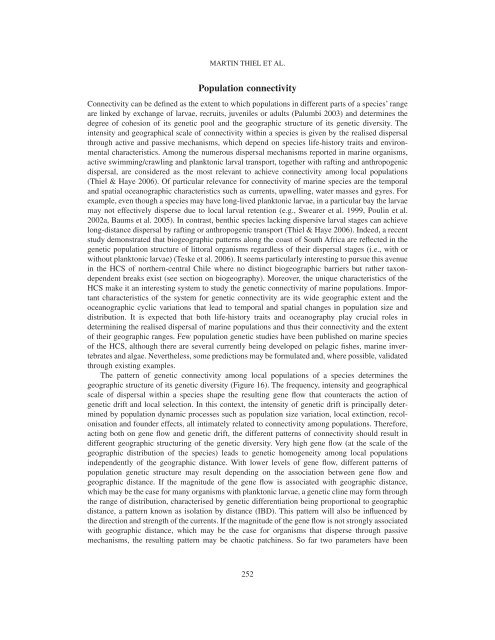the humboldt current system of northern and central chile - figema
the humboldt current system of northern and central chile - figema
the humboldt current system of northern and central chile - figema
You also want an ePaper? Increase the reach of your titles
YUMPU automatically turns print PDFs into web optimized ePapers that Google loves.
MARTIN THIEL ET AL.Population connectivityConnectivity can be defined as <strong>the</strong> extent to which populations in different parts <strong>of</strong> a species’ rangeare linked by exchange <strong>of</strong> larvae, recruits, juveniles or adults (Palumbi 2003) <strong>and</strong> determines <strong>the</strong>degree <strong>of</strong> cohesion <strong>of</strong> its genetic pool <strong>and</strong> <strong>the</strong> geographic structure <strong>of</strong> its genetic diversity. Theintensity <strong>and</strong> geographical scale <strong>of</strong> connectivity within a species is given by <strong>the</strong> realised dispersalthrough active <strong>and</strong> passive mechanisms, which depend on species life-history traits <strong>and</strong> environmentalcharacteristics. Among <strong>the</strong> numerous dispersal mechanisms reported in marine organisms,active swimming/crawling <strong>and</strong> planktonic larval transport, toge<strong>the</strong>r with rafting <strong>and</strong> anthropogenicdispersal, are considered as <strong>the</strong> most relevant to achieve connectivity among local populations(Thiel & Haye 2006). Of particular relevance for connectivity <strong>of</strong> marine species are <strong>the</strong> temporal<strong>and</strong> spatial oceanographic characteristics such as <strong>current</strong>s, upwelling, water masses <strong>and</strong> gyres. Forexample, even though a species may have long-lived planktonic larvae, in a particular bay <strong>the</strong> larvaemay not effectively disperse due to local larval retention (e.g., Swearer et al. 1999, Poulin et al.2002a, Baums et al. 2005). In contrast, benthic species lacking dispersive larval stages can achievelong-distance dispersal by rafting or anthropogenic transport (Thiel & Haye 2006). Indeed, a recentstudy demonstrated that biogeographic patterns along <strong>the</strong> coast <strong>of</strong> South Africa are reflected in <strong>the</strong>genetic population structure <strong>of</strong> littoral organisms regardless <strong>of</strong> <strong>the</strong>ir dispersal stages (i.e., with orwithout planktonic larvae) (Teske et al. 2006). It seems particularly interesting to pursue this avenuein <strong>the</strong> HCS <strong>of</strong> nor<strong>the</strong>rn-<strong>central</strong> Chile where no distinct biogeographic barriers but ra<strong>the</strong>r taxondependentbreaks exist (see section on biogeography). Moreover, <strong>the</strong> unique characteristics <strong>of</strong> <strong>the</strong>HCS make it an interesting <strong>system</strong> to study <strong>the</strong> genetic connectivity <strong>of</strong> marine populations. Importantcharacteristics <strong>of</strong> <strong>the</strong> <strong>system</strong> for genetic connectivity are its wide geographic extent <strong>and</strong> <strong>the</strong>oceanographic cyclic variations that lead to temporal <strong>and</strong> spatial changes in population size <strong>and</strong>distribution. It is expected that both life-history traits <strong>and</strong> oceanography play crucial roles indetermining <strong>the</strong> realised dispersal <strong>of</strong> marine populations <strong>and</strong> thus <strong>the</strong>ir connectivity <strong>and</strong> <strong>the</strong> extent<strong>of</strong> <strong>the</strong>ir geographic ranges. Few population genetic studies have been published on marine species<strong>of</strong> <strong>the</strong> HCS, although <strong>the</strong>re are several <strong>current</strong>ly being developed on pelagic fishes, marine invertebrates<strong>and</strong> algae. Never<strong>the</strong>less, some predictions may be formulated <strong>and</strong>, where possible, validatedthrough existing examples.The pattern <strong>of</strong> genetic connectivity among local populations <strong>of</strong> a species determines <strong>the</strong>geographic structure <strong>of</strong> its genetic diversity (Figure 16). The frequency, intensity <strong>and</strong> geographicalscale <strong>of</strong> dispersal within a species shape <strong>the</strong> resulting gene flow that counteracts <strong>the</strong> action <strong>of</strong>genetic drift <strong>and</strong> local selection. In this context, <strong>the</strong> intensity <strong>of</strong> genetic drift is principally determinedby population dynamic processes such as population size variation, local extinction, recolonisation<strong>and</strong> founder effects, all intimately related to connectivity among populations. Therefore,acting both on gene flow <strong>and</strong> genetic drift, <strong>the</strong> different patterns <strong>of</strong> connectivity should result indifferent geographic structuring <strong>of</strong> <strong>the</strong> genetic diversity. Very high gene flow (at <strong>the</strong> scale <strong>of</strong> <strong>the</strong>geographic distribution <strong>of</strong> <strong>the</strong> species) leads to genetic homogeneity among local populationsindependently <strong>of</strong> <strong>the</strong> geographic distance. With lower levels <strong>of</strong> gene flow, different patterns <strong>of</strong>population genetic structure may result depending on <strong>the</strong> association between gene flow <strong>and</strong>geographic distance. If <strong>the</strong> magnitude <strong>of</strong> <strong>the</strong> gene flow is associated with geographic distance,which may be <strong>the</strong> case for many organisms with planktonic larvae, a genetic cline may form through<strong>the</strong> range <strong>of</strong> distribution, characterised by genetic differentiation being proportional to geographicdistance, a pattern known as isolation by distance (IBD). This pattern will also be influenced by<strong>the</strong> direction <strong>and</strong> strength <strong>of</strong> <strong>the</strong> <strong>current</strong>s. If <strong>the</strong> magnitude <strong>of</strong> <strong>the</strong> gene flow is not strongly associatedwith geographic distance, which may be <strong>the</strong> case for organisms that disperse through passivemechanisms, <strong>the</strong> resulting pattern may be chaotic patchiness. So far two parameters have been252










